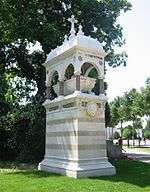Carl Ritter von Ghega
| Carl Ritter von Ghega | |
|---|---|
 Carl Ritter von Ghega, drawn by Joseph Kriehuber, 1851 | |
| Born |
Carlo Ghega 10 January 1802 Venice, Venetian Province, Habsburg Monarchy (now Italy) |
| Died |
14 March 1860 (aged 58) Vienna, Austrian Empire (now Austria) |
| Resting place | Zentralfriedhof, Vienna |
| Nationality | Austrian |
| Ethnicity | Albanian |
| Occupation | Engineer |
| Known for | designing and engineering the Semmering Railway |
Carl Ritter von Ghega or Karl von Ghega (10 January 1802 – 14 March 1860) was the designer of the Semmering Railway from Gloggnitz to Mürzzuschlag. During his time, he was the most prominent of Austrian railway engineers and architects.[1]
Biography
Born in Venice as Carlo Ghega from an Albanian family.[2] His father, Anton Ghega, was an officer in the Austrian navy in the government service.[1] he studied in Padua, where he took the examination for doctor of mathematics at the age of 18. He was attached to the Imperial board of Public Buildings when the railway movement commencing throughout Europe attracted his attention.[1] He began his engineering career with road and hydraulic engineering in Venice. Among other things he contributed to the building of the road over Cortina d'Ampezzo to Toblach. From 1836 to 1840 he was a construction supervisor for the railway track from Brno to Břeclav, the so-called Emperor Ferdinand North Railway. During this time, in 1836 and 37 he studied also the railways in England and other European countries. In 1842, entrusted with the entire planning of the future state railway, he made a study trip to North America.

After his return to the state railway he began with the planning of the railway line to the south, from Mürzzuschlag to Graz and Trieste. The crossing of the Semmering was not believed possible, but as early as 1844 he submitted a plan for the crossing of the Semmering, with locomotives without an extra rail for gear wheels. Before the building was fully decided, he began to enforce the construction of locomotives which could overcome such upward gradients. Construction of the Semmeringbahn was begun in 1848 and completed in 1854. In 1856, the Borovnica viaduct, one of the most imposing railroad bridges of the era, was built upon the plans by von Ghega as part of the Austrian Southern Railway from Vienna to Trieste.
In 1851, Ghega was knighted (Ritter) for his services to the country, and in 1853 he was made chief of planning for the whole railway network of the Austrian Empire.[2]
Carl von Ghega was next assigned to the building of a railway in Transylvania, but he could not see this project to its end because of his death in Vienna from tuberculosis.
References
- 1 2 3 The Architect, Volume 3. 175 Strand W.C. 1870. p. 184.
- 1 2 Robert Elsie (24 December 2012). A Biographical Dictionary of Albanian History. I.B.Tauris. p. 166. ISBN 978-1-78076-431-3.
Further reading
| Wikimedia Commons has media related to Carl Ritter von Ghega. |
- Dinhobl, Günter (2003). Die Semmeringerbahn: der Bau der ersten Hochgebirgseisenbahn der Welt. Wien: Grasl Druck & Neue Medien. p. 228. ISBN 3-486-56743-8. Retrieved 2011-02-20.
Regarding personal names: Ritter is a title, translated approximately as Sir (denoting a Knight), not a first or middle name. There is no equivalent female form.
|
